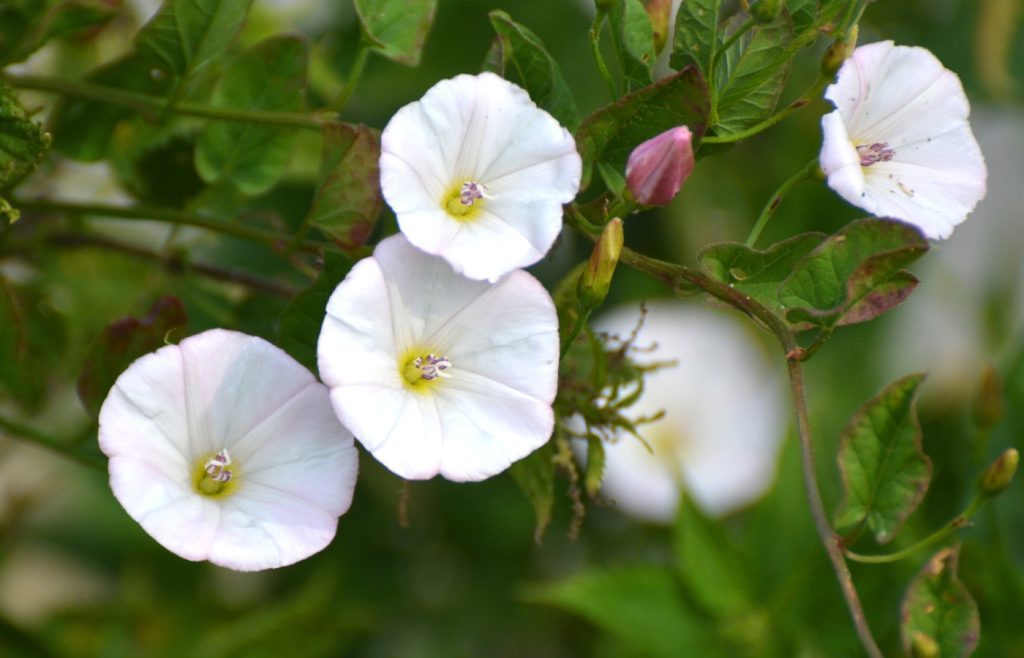The bindweed, a resilient climbing plant, is often a nightmare for gardeners. Its long stems wrap around neighboring plants, depriving them of light, water, and essential nutrients.
Yet, with natural and environmentally friendly methods, it’s possible to limit its invasion and maintain a healthy garden. Here’s everything you need to know to effectively identify and combat bindweed.
Identify the type of bindweed: hedges or fields?
Before embarking on the battle against bindweed, it’s crucial to correctly identify the species in question. Two main types infest gardens:
Hedge bindweed (Calystegia sepium)

This species is often found along hedges, fences, and in wastelands. It is easily recognizable by its broad arrow-shaped leaves and large trumpet-shaped white flowers that bloom abundantly between July and September.
With its deeply anchored roots and twining stems, hedge bindweed is a formidable opponent.
Field bindweed (Convolvulus arvensis)
More discreet but equally invasive, field bindweed prefers open areas such as fields and vegetable gardens.
Its leaves are smaller, often light green, and its flowers are more modest, either white or pink. Its long stems of several meters crawl and climb, suffocating nearby plants.

Natural methods to combat bindweed
- Manual removal: Bindweed can be pulled up by hand, but this method requires consistency. Wait for a day after it rains when the soil is loose to make it easier to extract the roots. Try to remove the plant from deep down, because even a small fragment of root left behind can lead to new growth. This intervention should be repeated frequently to limit spreading.
- Solarization: During the summer months, cover the infested areas with a clear plastic tarp. This process traps the sun’s heat, raising the soil temperature to a level that destroys the roots of bindweed. After several weeks, the soil will be free of the plant while being enriched by the decomposition of organic matter.
- Thermal weeding: For small patches of bindweed, a thermal weeder can be very effective. By applying intense heat to the leaves of the plant, you cause their dehydration and death. This method, which respects neighboring plants, is ideal for quick and precise elimination.
Additional tips to limit growth
Mulching
By covering the soil with organic materials like straw, wood chips, or fallen leaves, you block access to the light essential for the photosynthesis of bindweed.
This mulching also limits regrowth and retains soil moisture for your crops.
The can
Planting a can (open at both ends) around a bindweed shoot can prevent its roots from spreading.
This allows you to focus your efforts on a defined area and facilitates root removal.
Tagetes and green manures
Planting marigolds (tagetes) or using green manures can reduce the proliferation of bindweed.
These plants enrich the soil and produce natural compounds that inhibit the growth of bindweed. This method works particularly well in vegetable gardens.

Preventing invasion: a well-maintained garden
To prevent bindweed from taking over, adopt preventive measures:
- Eliminate young shoots as soon as they appear. Pulling them up quickly limits their spread.
- Practice crop rotation. This disrupts the growth cycles of bindweed.
- Avoid bare soil areas. These unoccupied spaces invite bindweed to settle.
Bindweed: a useful plant nonetheless?
Although invasive, bindweed does offer certain benefits. It can temporarily stabilize soil in cases of erosion and attracts pollinators with its flowers.
Moreover, some varieties possess medicinal properties used in phytotherapy. This dual aspect reminds us that a balance between management and tolerance can sometimes be considered.

